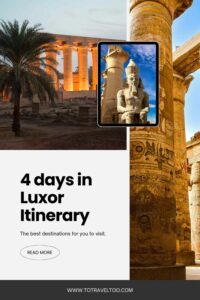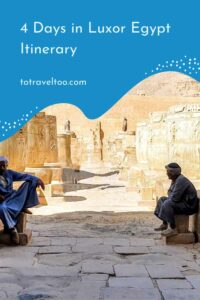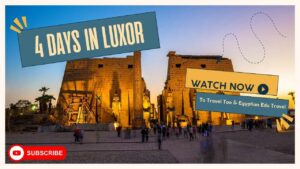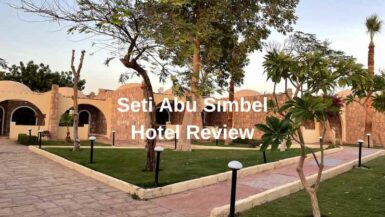Are you planning a trip to Luxor and wondering how to make the most of your time in this ancient city? Look no further! In this article, top things to do in Luxor in 4 days, we will guide you through an exciting itinerary that will allow you to explore the rich history and culture of Luxor. From visiting iconic landmarks such as the Karnak Temple Complex and Valley of the Kings, to experiencing traditional Egyptian cuisine and taking a hot air balloon ride over the Nile River – there is something for everyone in Luxor. So grab your camera, put on comfortable shoes, and get ready for an unforgettable adventure in one of Egypt’s most captivating destinations.

This post may contain affiliate links. Please see our disclosure for more information. As an Amazon Associate, we earn from qualifying purchases (if applicable).
Need an E-Sim whilst in Luxor
Summary of 4 Days in Luxor Itinerary
Day One Luxor
Visit Karnak and Luxor Temples after you arrive in Luxor
Day Two Luxor
Hot Air Balloon Flight
Valley of Kings, King Tut Tomb, Ramses IV tomb, Hatshepsut Temple, Colossi of Memnon
At night visit the Karnak Sound & Light Show
Day Three Luxor
Dendara Temple and Abydos Temple
Day Four Luxor
Temple of Medinet Habu – Ramessum Temple, Valley of Queens, Tomb of Queen Nefetari, horse and carriage ride through Luxor and the Mummification Museum
We have put together our YouTube video on our time spent in Luxor. You can check it out below.
You have two options on how to visit Luxor.
Option 1: Book hotels, tours and transfers independently
Option 2: Our preferred option is to use the services of an Egyptian Tour Company that provides you with a driver and an Egyptologist as we did. We wanted to make the most of our time in Egypt by visiting the famous sites, for us having our driver and Egyptologist was the way to go. We were not rushed from site to site but could spend as long as we wanted to. Our preferred tour company is Egyptian Edu Travel. NB: Egyptian EDU Travel will purchase all your tickets for you and can book hotel accommodations.
We have a special offer for our readers – if you book your travel through Egyptian Edu Travel and quote TTT2024 there is a 5% discount available.
Contact email: [email protected]
Where to Stay in Luxor

During our time in Luxor, we stayed in both the Sofitel Winter Palace and its sister hotel on the same grounds Hotel Sofitel Pavillion Luxor. We changed hotels due to a lack of accommodation on our last night at the Winter Palace. We are glad we did as it gave us a good feel for both properties that share the same gardens and pool area.
We can highly recommend both properties for their location, comfort, service, restaurants and bars. The views over the River Nile from the Sofitel Winter Palace are outstanding, especially in the early morning when you can see the flight of the Hot Air Balloons over the West Bank of the Nile.
For bookings for the Sofitel Winter Palace click here
You can read our review of the Sofitel Winter Palace here
You can read our review of the Pavillon Winter Palace here

For bookings for the Hotel Sofitel Pavillion click here
Day One Arrival in Luxor – Karnak Temple and Luxor Temple
There are several flight options daily from Cairo to Luxor using Egypt Air or Air Cairo. The flight duration is 1 hour. For the latest timetable and fares click here.
Karnak Temple

Our driver and Egyptologist met us at Luxor Airport to take us to Karnak Temple a 13-minute drive away.
The impressive Great Hypostyle Hall with its 134 gigantic columns arranged in 16 rows is magnificient. The Karnak Complex is the 2nd most visited site in Egypt, the first being the Pyramids of Giza.
What blows you away when you visit Karnak is the height and width of these columns. 122 columns are 10 m high and the other 12 are 21 m high and with a diameter of 3 metres. The beautifully adorned architraves weigh around 70 tons. The Karnak Complex covers an area of 200 acres and is the largest temple complex in the world. Not only is it the largest but it was constructed over 1300 years, each pharaoh adding their mark to it during their reign between 2055 BC and 100 AD. It was dedicated to the Gods Amun, Mut, and Khonsu. Not all of the complex is open to the public.
The Sacred Lake is where priests perform ritual washing before performing religious ceremonies.
Two massive obelisks are located in the Karnak Complex – Thutmose I (1520-1492 BCE reign) and Hatshepsut (1479-1458BCE reign). Hatshepsut Obelisk weighs in at 343 tonnes and stands at 28.5m tall. Thutmose I obelisk stands 24m high and weighs 143 tonnes.

The Karnak Complex runs Light and Sound Shows. There are different timings each night and in different languages such as German, English, Arabic and French.
You can purchase your Karnak Temple Entrance Ticket with Audio Guide here
Book your Karnak Temple Light & Sound Show Tickets here
Opening times: 6 am to 4 pm daily. In summer 6 am to 5 pm.
Address: Sharia al-Karnak
Luxor Temple

A 5-minute drive away from Karnak Temple is Luxor Temple located in the centre of Luxor itself. We arrived late in the afternoon as the sun was setting and the light was casting a golden glow across the temple.
Luxor Temple also was dedicated to Amun (the Great God), Mut (his wife) and Khonsu (his son) and was built by Amenhotep III. Later in the 19th Dynasty Ramses II added a new court and entrance. It was built with sandstone from the Gebel el-Silsila area which we visited on our Nour el Nil dhabiya cruise.
Ramses II constructed the first pylon that stands 24 m high. Originally there were 6 statues of himself, now all that is left is 2 seated and 1 standing. Only 1 of the two obelisks is still standing in the complex the other being at the Place de la Concorde in Paris.
As you move through the complex you enter the Great Court of Ramses II, the Mosque of al-Haggag, the Colonnade of Amenhotep III, the Sun Court of Amenhotep III, the Hypostyle Hall (with its 32 columns in 4 rows of eight) and the Barque Shine of Amun. There is also a birth room with scenes showing the birth of Amenhotep III and finally the remains of the Sanctuary of Amenhotep III.
If you continue walking back to the entrance of the Temple in front of you is the magnificent Avenue of the Sphinxes which will link the Karnak and Luxor Temples 3 km away.
You can purchase your Luxor Temple Entrance Tickets with Audio Guide here
Day Two Luxor – Hot Air Balloon Ride, Valley of Kings, King Tut Tomb, Ramses IV tomb, Hatshepsut Temple, Colossi of Memnon and the Light and Sound Show Karnak Temple
Hot Air Balloon Ride
Unfortunately due to a sandstorm coming our way our flight was cancelled.
Top travel tip: When booking the Hot Air Balloon flight arrange it for the 2nd day of your visit. This allows you to book another day if the flight is cancelled due to the weather.
We have flown twice in Hot Air Balloons – Cappadocia in Turkey and Bagan in Myanmar and our Cappadocia was cancelled on the first day due to weather.
Valley of the Kings

The New Kingdom Pharaohs thought they had the answer to their tombs being plundered by those searching for the riches within them. They constructed their tombs deep in the Theban hills on the West Bank of the Nile, unfortunately, the only ones that remained intact were the tombs of Yuya and Tuya (KV46) and the boy Pharaoh Tutankhamun (KV62).
The New Kingdom was from 1550 – 1069 BC and the rulers were from the 18th, 19th and 20th Dynasties. The famous kings during this period were Ramses II, Tuthmosis III, and Seti I and the most famous Tutankhamun.
The mountain peak of al-Qurn dominates the Valley which is made up of the East and West Valleys. If you look up to the peak from the Valley you will note that it is shaped like a pyramid. Most of the tombs are located in the East Valley.
There are 64 numbered tombs and chambers that have been discovered so far eg KV62 (KV means Kings Valley).
Tips on visiting the Valley of the Kings:
The best time to visit the Valley of the Kings is during October and April. The busiest time during the day to visit is between 10 am and 2 pm.
Opening hours: Winter 6 am to 4 pm Summer 6 am to 5 pm
How to get to the Valley of the Kings:

- Part of a private tour with driver and Egyptologist as mentioned above when we travelled with Egyptian Edu Travel.
- Hire a driver for the visit. A taxi can be organised through your hotel. You can purchase a skip-the-line entry ticket here.
- The entrance ticket for the Valley of the Kings covers eight tombs, of which you are allowed to visit three: (Ramesses VII, Ramesses IX, Merenptah, Ramesses III, Tausert-Setnakht, Seti II, Ramesses I, Siptah & the tomb of Ramesses IV) There are three additional tombs that you can visit with an extra ticket purchased at the same time of your main ticket. (Ramesses V & VI, Seti I & Tutankhamun Tombs). The mini train ride takes around 3 minutes once you are inside the complex and is an extra cost.
- Catch the ferry across the river and then hire a taxi.
- Book a tour to the Valley of the Kings and Hatshepsut Temple that includes lunch and pick up and drop off at your hotel (you still need to purchase an entry ticket)
Good to know: Your tour guide is not allowed inside the tombs with you. If you want to view extra tombs these will need to be purchased at the same time as your main entrance ticket. The tombs that you will need to pay extra for are:
- Ramesses V & VI
- Seti I
- Tutankhamun
- Tomb of Ay in the West Valley. NB. It is a 2 km walk to the Tomb of Ay.
Hatshepsut Mortuary Temple

To reach Hatshepsut Temple it is a 10-minute drive from the Valley of the Kings.
Opening hours: 6 am to 4 pm in Winter and in Summer 6 am to 5 pm
Who was Pharaoh Hatshepsut? She was Thutmosis II’s wife and became the ruler on his death. His son Thutmosis III, the stepson of Hatshepsut, was only two at that time. Even when he came of age she co-ruled with him. Her reign lasted 20 years. During that time she constructed new buildings, renovated old buildings and developed trade routes.
The impressive 3 storey mortuary temple is a masterpiece of its time. The three levels that are seen as you enter the complex do remind you of the shape of a pyramid tomb. The magnificent sphinx also at the entrance bears the image of the head of Hatshepsut.
Once inside the temple, you will be impressed with the images depicting her life from the time she became ruler to her death. Some images of Hatshepsut have been vandalised in certain areas e.g. Shrine of Anubis. Was this because she was a female? Archaeologists are still out on this one! The three levels contain the Upper Court with its open courtyard and columns, the Middle Court with the impressive Osiride statues of Hatshepsut and the two chapels of Hathor and the Chapel of Anubis. The Lower Court with its courtyard where once a garden flourished has behind it a colonnade of square columns. These columns were once decorated with images of Hatshepsut but they too were vandalised.
From the 6th to the 8th century, the Coptic Church used the complex, and some of the frescoes have been painted over.
Colossi of Memnon

On the West Bank are the two impressive statues reaching up to 18 m high of Amenhotep III. They are estimated to weigh 720 tons each. They were completed in 1350 BCE. It is said that the northernmost statue sings at sunrise. This could be because of a previous earthquake that damaged the statue and the wind whistles through the damaged area.
Light and Sound Show Karnak Temple
We enjoyed the evening Light and Sound Show at Karnak Temple.
The show takes you on a journey through time, unravelling the stories of the great rulers, battles, and religious rituals that took place in Karnak’s hallowed halls.
There are different timings each night and in different languages such as German, English, Arabic and French.
You can pre-purchase your tickets here.
Day Three in Luxor – Dendara Temple and Abydos Temple

Dendara Temple is located 84 km from Luxor and Abydos Temple is located 170 km from Luxor. This is a longer day than usual due to the distance. It is worth the journey and we recommend using the services of an Egyptologist.
The temple dates back to the Ptolemaic period and is dedicated to the Goddess Hathor, the lady of the Sky. Hathor was the mother of the Sky God Horus and the Sun God Ra. She is depicted wearing a headdress of cow horns.
The complex includes Roman and Ptolemaic Greek buildings and a 5th-century Coptic church. The complex is spread over 10 acres.
There is a copy of the Dendara Zodiac ceiling representing the movement of the moon, sun and stars and the constellations as we know them today. The original was removed in 1820 and is in the Louvre in Paris. It is stated to be the world’s first horoscope.
Tips about visiting Dendara Temple:
Visit in Spring, Autumn or Winter – June and July the temperatures reach 34 deg C. Ensure you take a hat, good walking shoes and plenty of water.
We recommend hiring a driver and Egyptologist or booking a tour. It is not a site to reach by public transport.
You can purchase your entry ticket here
Abydos Temple

The Grand Temple of Abydos is also known as the Temple of Seti I. The temple is well known for its colourful carvings which were built by King Set I and finished by his son Rameses II. It was constructed mainly in limestone in an unusual l-shape which consists of a terrace, chambers, chapels, courts and pylons. It was built during the 19th Dynasty.
Check out the Temple of Seti I and the Temples of Rameses II, tour the Galley of the Kings in the South Wing of the Temple and visit the Osireion.
There is an Abydos King List in the temple that lists 76 Pharaohs and is an important document for historians.
It is a fairly long day but worth the visit. Plan to spend at least 90 minutes in each Temple – Dendara and Abydos.
Opening times for Abydos – 8 am to 5 pm (7 am to 6 pm in Summer).
You can visit by train from Luxor arriving at El Balyana Station. Abydos is 12 km away by taxi.
Day 4 – Temple of Medinet Habu- Ramesseum Temple, Valley of the Queens and the Tomb of Queen Nefertari, horse and carriage ride through Luxor and the Mummification Museum

On the West Bank of the Nile is the Mortuary Temple of Ramesses III known as Medinet Habu which was constructed in the 20th Dynasty. It is located on the 2nd largest site in Egypt of 66,000 square metres. The Temple is known for its intricate carvings and colourful hieroglyphics. The reliefs in the 2nd court depict the battles with the Sea Peoples, who were seafarers who invaded during the reign of Ramses III.
During your visit, you will enter through the main entrance and outer court where you will find the small temple Djeser Set which was dedicated to the God Amun. You then continue to the First Court, Second Court, Halls and Sanctuaries, Palaces and Outer Walls.
Unfortunately, the site was abandoned around 700 BCE where it was used by the Coptic Christian Monasteries.
Opening Hours: 6 am to 4 pm in winter and 6 am to 5 pm in summer
You can visit as part of an organised tour or one that you have booked with your tour company such as Egyptian EDU travel.
You can organise a taxi from Luxor. Negotiate the fare before you accept the ride.
The Ramesseum
Ramses II reigned for 67 years and built The Ramesseum as his mortuary temple. It took 20 years to complete and today stands in ruins.
Scenes of Ramses II reign are shown in the many hieroglyphics and reliefs. When you visit the 2nd court you will come across the head of the Colossus of Ramses lying on the ground. The Colossus stood at 18 m high and weighed around 1000 tonnes.
The mud-brick granaries and storehouses can be visited in the complex. They were constructed to store grain and corn and showed the immense wealth of the Pharaoh. The grain was shipped around Egypt.
Opening hours: 6 am to 5 pm and allow at least an hour to visit.
Valley of the Queens

To the southwest of the Valley of the Kings is the Valley of the Queens which is the funerary complex for many of the royal wives and children from the 19th Dynasty. The most famous of all the 80 tombs belongs to Queen Nefertari.
Only 4 tombs can be visited – Queen Nefertari (#66), Amunherkhepshep (#55), Titi (#52) and Khaemweset #44).
Good to know: a separate ticket is needed to visit the tomb of Queen Nefertari, it is quite costly. Her tomb is the most colourful, make sure you look up at the ceiling and enjoy the night sky of stars. You are allowed to visit the tomb for 10 minutes.
How to get to the Valley of the Queens from Luxor:
- Part of an organised tour 2
- Taxi to the ferry that crosses to the West Bank and then a taxi to the site
- Taxi from Luxor and return
Opening hours: 6 am to 4 pm in winter and in summer 6 am to 5 pm
Time to allow to visit: approximately 1 hour
Horse and Carriage Ride Through Luxor
Board the horse carriage and get your camera ready as you discover the ancient city. First, travel through a historic village and get a glimpse into the ancient Egyptian way of life. Learn about the history of Luxor and Egyptian traditions and customs from your guide. Proceed inside the city to see the Mosque of Abu Haggag, one of the oldest places of continuous worship in the world, with a history dating back over 3400 years. Pass the bustling souq full of locals and travellers searching for bargains and local goods. See numerous Coptic Christian churches built along the east bank. Marvel at the famous Luxor Temple built by Ramses II around the year 1400 BC. After learning more about each site, be returned to your hotel.
The Mummification Museum
Address: Corniche-el-Nil opposite Mena Palace Hotel
Open: 9 am to 3 pm daily
Discover how the Ancient Egyptians applied embalming techniques to many species, not only to dead humans. Mummies of cats, fish, and crocodiles are on display in this unique museum, where one can also get an idea of the tools used.
In conclusion, a four-day visit to Luxor offers a unique opportunity to immerse oneself in the ancient history and culture of Egypt. From exploring iconic landmarks such as the Valley of the Kings and Karnak Temple, to cruising along the Nile River at sunset, Luxor is truly a destination that captivates the imagination and leaves a lasting impression. Whether you are a history buff, an adventure seeker, or simply looking for a one-of-a-kind travel experience, Luxor has something to offer everyone. With its rich history, stunning architecture, and warm hospitality, Luxor is sure to leave you with memories that will last a lifetime.
Where to next?
Dahabiya cruise on the Nile from Esna to Aswan
Flights to Luxor
For the latest prices and schedules for flights to Luxor click here
To Travel Too Travel Shop
Travel smarter and safer with products from our To Travel Too Travel Shop. If you are looking for the latest luggage, guidebooks or travel accessories we have you covered with over 800 travel products to choose from
Travel Insurance
World Nomads offers simple and flexible travel insurance. Buy at home or while travelling and claim online from anywhere in the world.
Accommodation in Luxor
For the latest deals from hostels to luxury hotels click here
Are you on Pinterest? We are at To Travel Too and we have many travel-related boards check us out at Pinterest. If you enjoyed our article why not pin it to your board and read it later?



Where to next?





Leave a reply